brake TOYOTA PRIUS 2009 2.G Owners Manual
[x] Cancel search | Manufacturer: TOYOTA, Model Year: 2009, Model line: PRIUS, Model: TOYOTA PRIUS 2009 2.GPages: 508, PDF Size: 6.84 MB
Page 2 of 508

TABLE OF CONTENTSIndex
2
PRIUS_U_(OM47614U)
1-1. Hybrid systemHybrid system ...................... 22
1-2. Key information Keys ..................................... 34
1-3. Opening, closing and locking the doors and back door
Smart key system................. 36
Wireless remote control ....... 49
Side doors ............................ 51
Back door ............................. 54
1-4. Adjustable components (seats, mirrors,
steering wheel)
Front seats ........................... 57
Rear seats ............................ 59
Head restraints ..................... 62
Seat belts ............................. 64
Steering wheel ..................... 71
Anti-glare inside rear view mirror .................................. 72
Outside rear view mirrors ..... 74
1-5. Opening and closing the windows and moon roof
Power windows .................... 76 1-6. Refueling
Opening the fuel tank cap..... 79
1-7. Theft deterrent system Immobilizer system ............... 82
Alarm .................................... 84
Theft prevention labels (U.S.A.) ............................... 86
1-8. Safety information Correct driving posture ......... 87
SRS airbags ......................... 89
Front passenger occupant classification system ......... 101
Child restraint systems ....... 107
Installing child restraints ..... 111
2-1. Driving procedures Driving the vehicle .............. 122
Power (ignition) switch........ 132
Transmission ...................... 138
Turn signal lever ................. 142
Parking brake ..................... 143
Horn .................................... 144
2-2. Instrument cluster Gauges and meters ............ 145
Indicators and warning lights ................................. 148
1Before driving
2When driving
Page 12 of 508
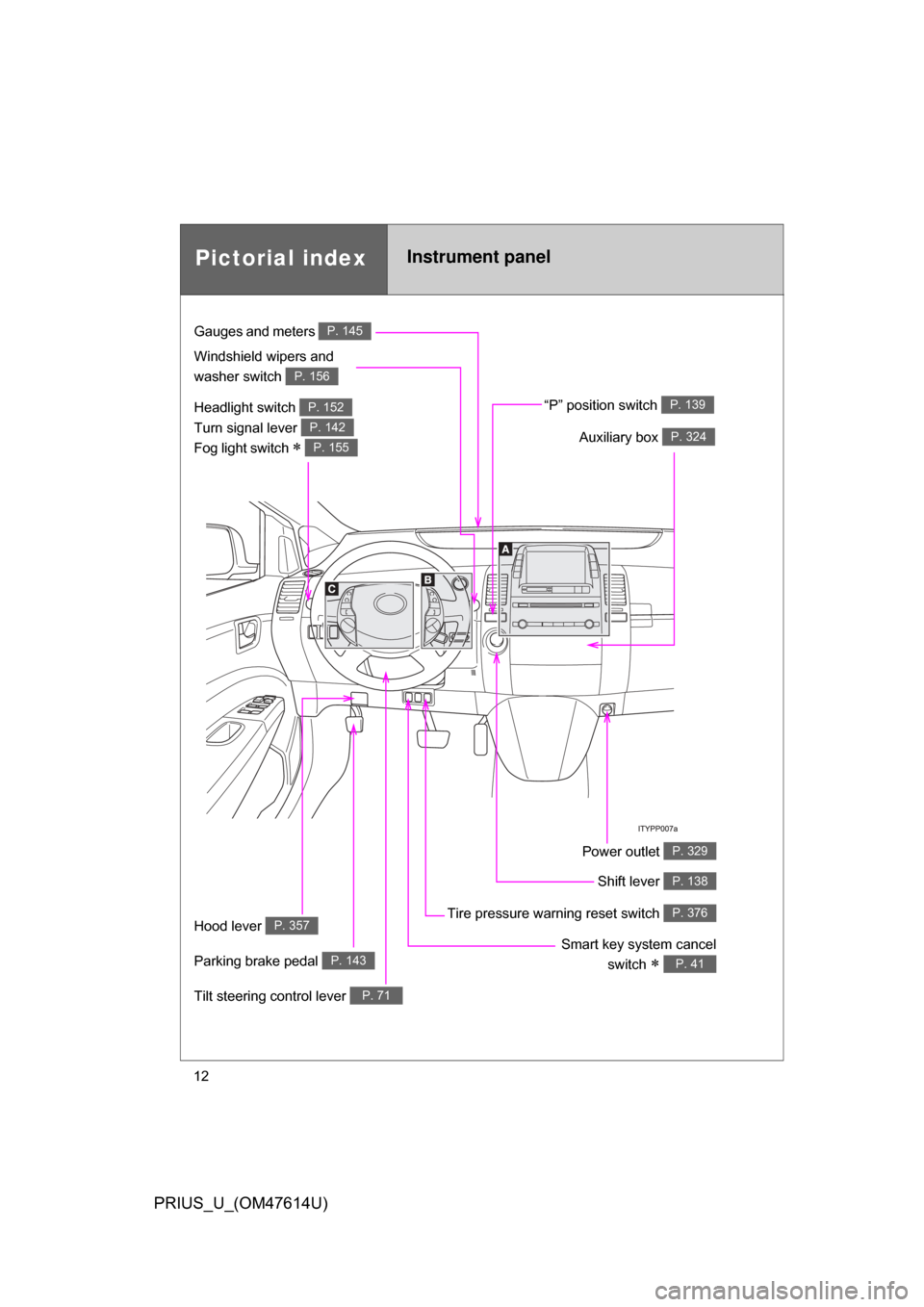
12
PRIUS_U_(OM47614U)
Pictorial indexInstrument panel
Headlight switch
Turn signal lever
Fog light switch
P. 152
P. 142
P. 155
Gauges and meters P. 145
Windshield wipers and
washer switch
P. 156
“P” position switch P. 139
Auxiliary box P. 324
Hood lever P. 357
Parking brake pedal P. 143
Power outlet P. 329
Smart key system cancelswitch
P. 41
Tire pressure warning reset switch P. 376
Tilt steering control lever P. 71
Shift lever P. 138
Page 17 of 508

17
PRIUS_U_(OM47614U)
Installation of a mobile two-way radio systemAs the installation of a mobile two- way radio system in your vehicle
could affect electronic systems such as the multiport fuel injection
system/sequential multiport fuel injection system, cruise control sys-
tem, anti-lock brake system, vehicle stability control system, SRS air-
bag system and seat belt pretensioner system and Toyota hybrid
system, be sure to check with your Toyota dealer for precautionary
measures or special instructions regarding installation.
High voltage parts and cables on th e hybrid vehicles emit approxi-
mately the same amount of elec tromagnetic waves as the conven-
tional gasoline powered vehicles or home electronic appliances
despite of their electromagnetic shielding.
Unwanted noise may occur in the reception of the mobile two-way
radio.
Scrapping of your Toyota
The SRS airbag and seat belt pret ensioner devices in your Toyota
contain explosive chemic als. If the vehicle is scrapped with the air-
bags and seat belt pretensioners left as they are, this may cause an
accident such as fire. Be sure to have the systems of the SRS airbag
and seat belt pretensioner removed and disposed of by a qualified
service shop or by your Toyota dealer before you scrap your vehicle.
Perchlorate Material
Special handling may apply,
See www.dtsc.ca.gov/hazar douswaste/perchlorate.
Your vehicle has components that may contain perchlorate. These
components may include airbag, seat belt pretensioners, and wire-
less remote control batteries.
Page 23 of 508
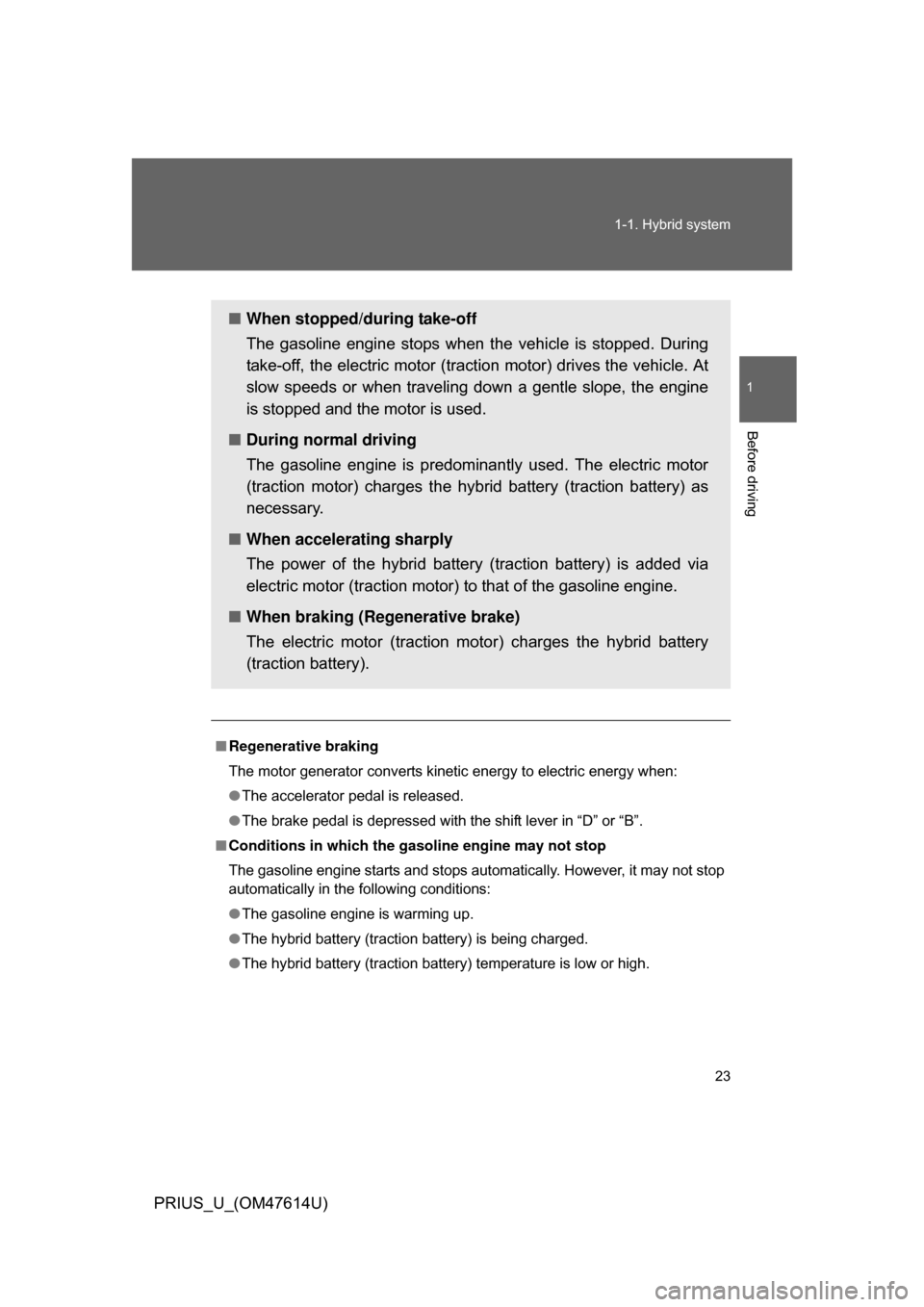
23
1-1. Hybrid system
1
Before driving
PRIUS_U_(OM47614U)
■
Regenerative braking
The motor generator converts kinetic energy to electric energy when:
● The accelerator pedal is released.
● The brake pedal is depressed with the shift lever in “D” or “B”.
■ Conditions in which the gasoline engine may not stop
The gasoline engine starts and stops automatically. However, it may not stop
automatically in the following conditions:
● The gasoline engine is warming up.
● The hybrid battery (traction battery) is being charged.
● The hybrid battery (traction battery) temperature is low or high.
■ When stopped/during take-off
The gasoline engine stops when the vehicle is stopped. During
take-off, the electric motor (traction motor) drives the vehicle. At
slow speeds or when traveling down a gentle slope, the engine
is stopped and the motor is used.
■ During normal driving
The gasoline engine is predominantly used. The electric motor
(traction motor) charges the hybr id battery (traction battery) as
necessary.
■ When accelerating sharply
The power of the hybrid battery (traction battery) is added via
electric motor (traction motor) to that of the gasoline engine.
■ When braking (Regenerative brake)
The electric motor (traction mo tor) charges the hybrid battery
(traction battery).
Page 25 of 508
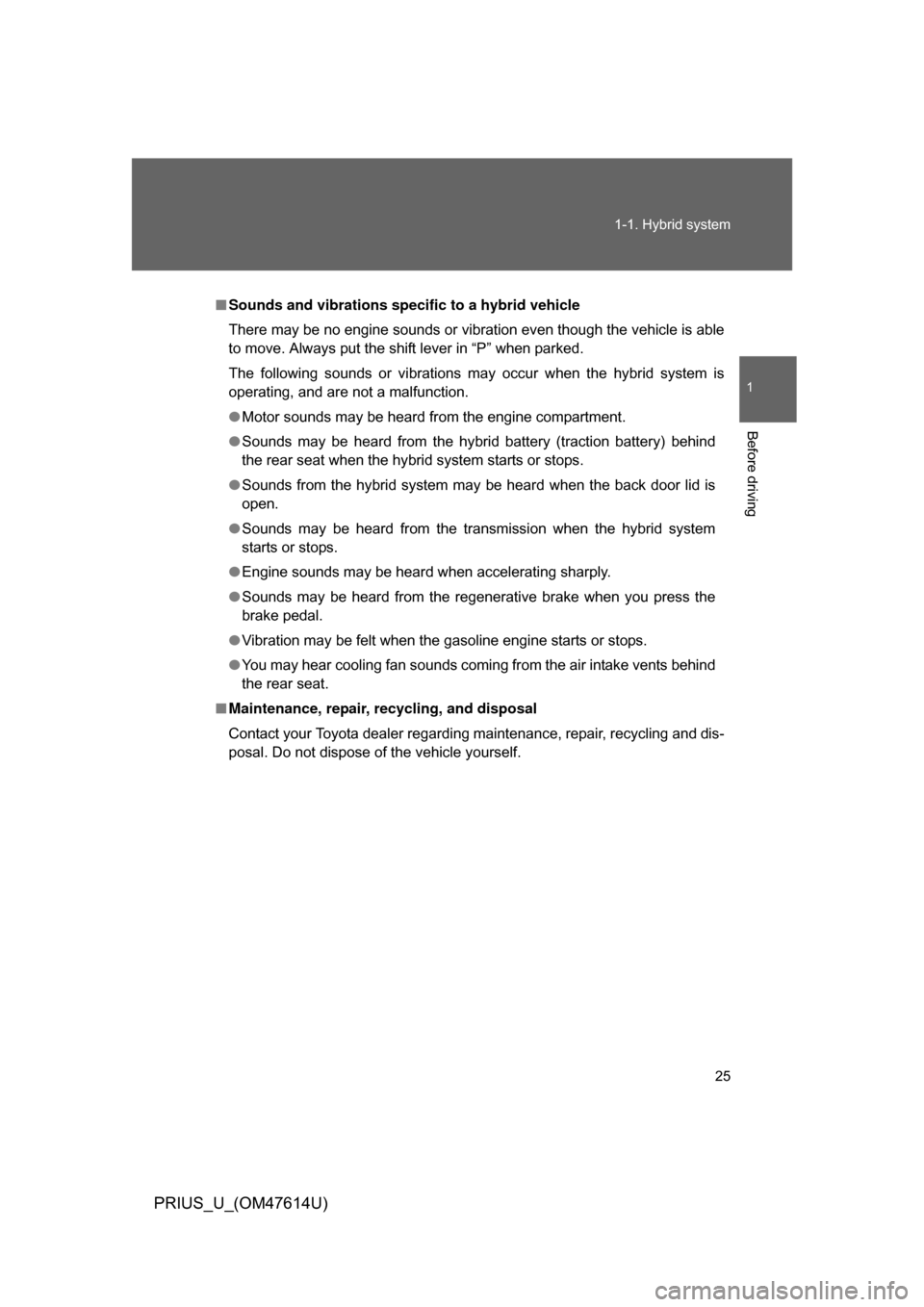
25
1-1. Hybrid system
1
Before driving
PRIUS_U_(OM47614U)
■
Sounds and vibrations specific to a hybrid vehicle
There may be no engine sounds or vibration even though the vehicle is able
to move. Always put the shift lever in “P” when parked.
The following sounds or vibrations may occur when the hybrid system is
operating, and are not a malfunction.
● Motor sounds may be heard from the engine compartment.
● Sounds may be heard from the hybrid battery (traction battery) behind
the rear seat when the hybrid system starts or stops.
● Sounds from the hybrid system may be heard when the back door lid is
open.
● Sounds may be heard from the transmission when the hybrid system
starts or stops.
● Engine sounds may be heard when accelerating sharply.
● Sounds may be heard from the regenerative brake when you press the
brake pedal.
● Vibration may be felt when the gasoline engine starts or stops.
● You may hear cooling fan sounds coming from the air intake vents behind
the rear seat.
■ Maintenance, repair, recycling, and disposal
Contact your Toyota dealer regarding maintenance, repair, recycling and dis-
posal. Do not dispose of the vehicle yourself.
Page 33 of 508
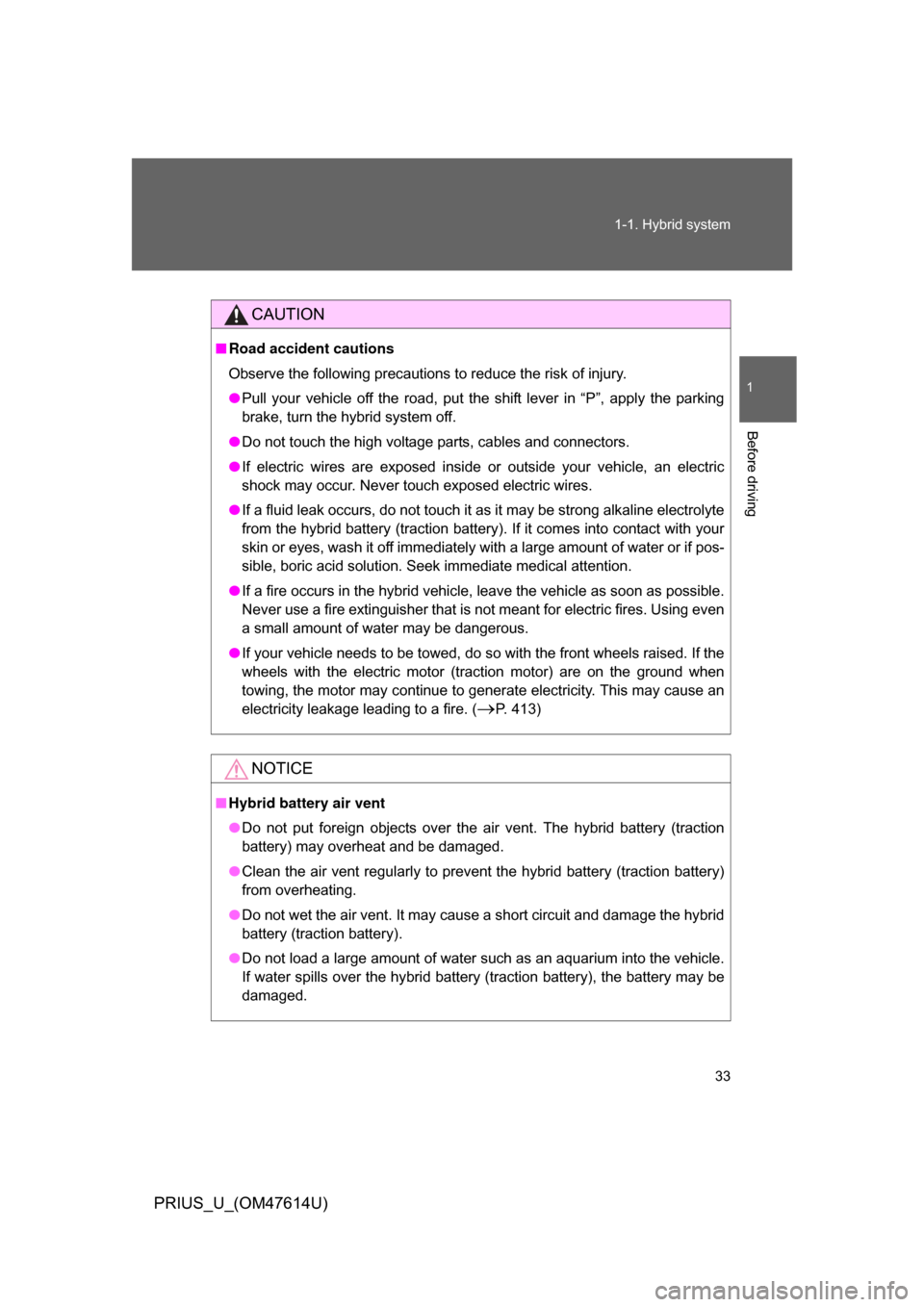
33
1-1. Hybrid system
1
Before driving
PRIUS_U_(OM47614U)
CAUTION
■
Road accident cautions
Observe the following precautions to reduce the risk of injury.
● Pull your vehicle off the road, put the shift lever in “P”, apply the parking
brake, turn the hybrid system off.
● Do not touch the high voltage parts, cables and connectors.
● If electric wires are exposed inside or outside your vehicle, an electric
shock may occur. Never touch exposed electric wires.
● If a fluid leak occurs, do not touch it as it may be strong alkaline electrolyte
from the hybrid battery (traction battery). If it comes into contact with your
skin or eyes, wash it off immediately with a large amount of water or if pos-
sible, boric acid solution. Seek immediate medical attention.
● If a fire occurs in the hybrid vehicle, leave the vehicle as soon as possible.
Never use a fire extinguisher that is not meant for electric fires. Using even
a small amount of water may be dangerous.
● If your vehicle needs to be towed, do so with the front wheels raised. If the
wheels with the electric motor (traction motor) are on the ground when
towing, the motor may continue to generate electricity. This may cause an
electricity leakage leading to a fire. (
P. 413)
NOTICE
■Hybrid battery air vent
● Do not put foreign objects over the air vent. The hybrid battery (traction
battery) may overheat and be damaged.
● Clean the air vent regularly to prevent the hybrid battery (traction battery)
from overheating.
● Do not wet the air vent. It may cause a short circuit and damage the hybrid
battery (traction battery).
● Do not load a large amount of water such as an aquarium into the vehicle.
If water spills over the hybrid battery (traction battery), the battery may be
damaged.
Page 121 of 508
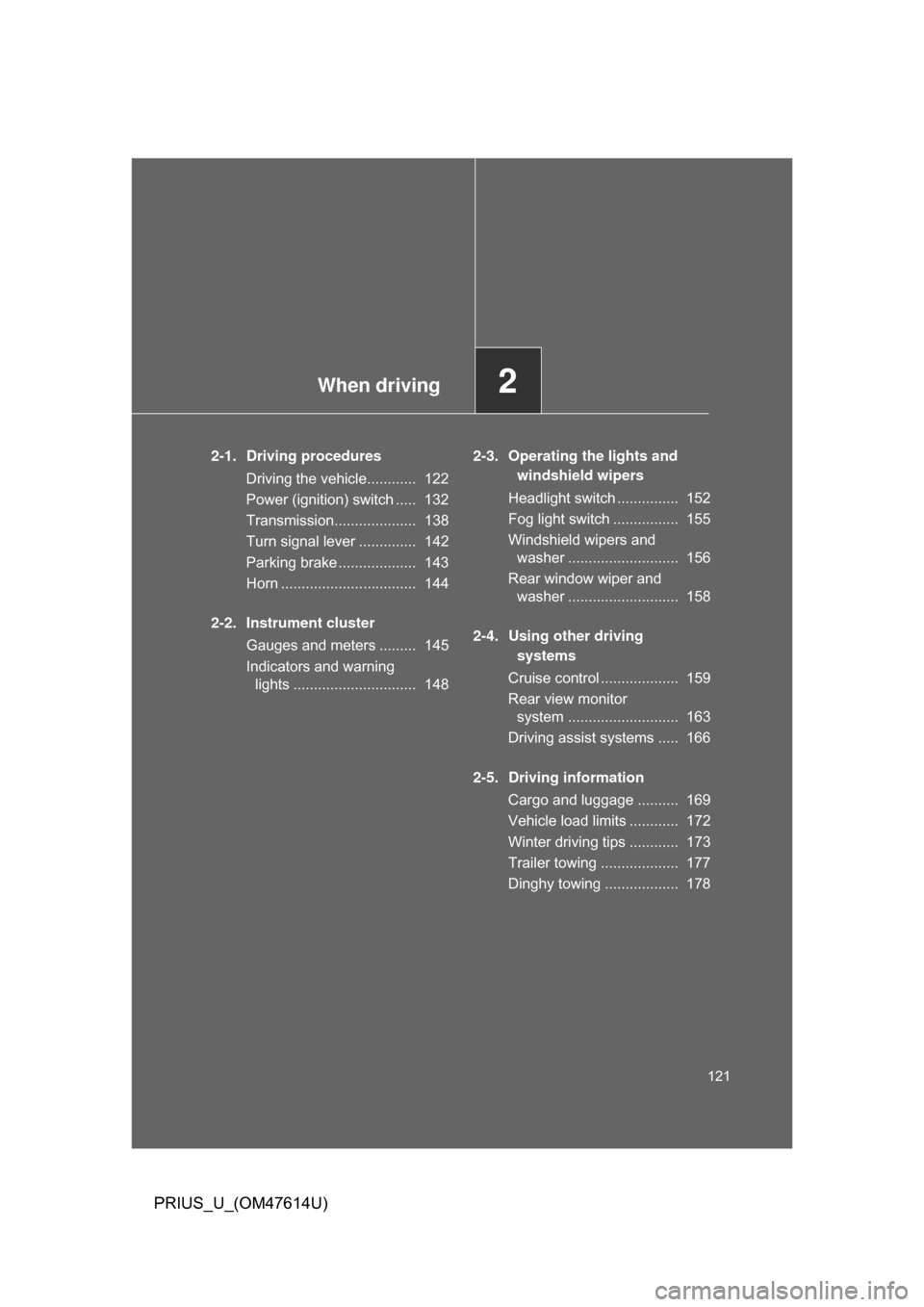
When driving2
121
PRIUS_U_(OM47614U)
2-1. Driving proceduresDriving the vehicle............ 122
Power (ignition) switch ..... 132
Transmission.................... 138
Turn signal lever .............. 142
Parking brake ................... 143
Horn ................................. 144
2-2. Instrument cluster Gauges and meters ......... 145
Indicators and warning lights .............................. 148 2-3. Operating the lights and
windshield wipers
Headlight switch ............... 152
Fog light switch ................ 155
Windshield wipers and washer ........................... 156
Rear window wiper and washer ........................... 158
2-4. Using other driving systems
Cruise control ................... 159
Rear view monitor system ........................... 163
Driving assist systems ..... 166
2-5. Driving information Cargo and luggage .......... 169
Vehicle load limits ............ 172
Winter driving tips ............ 173
Trailer towing ................... 177
Dinghy towing .................. 178
Page 122 of 508
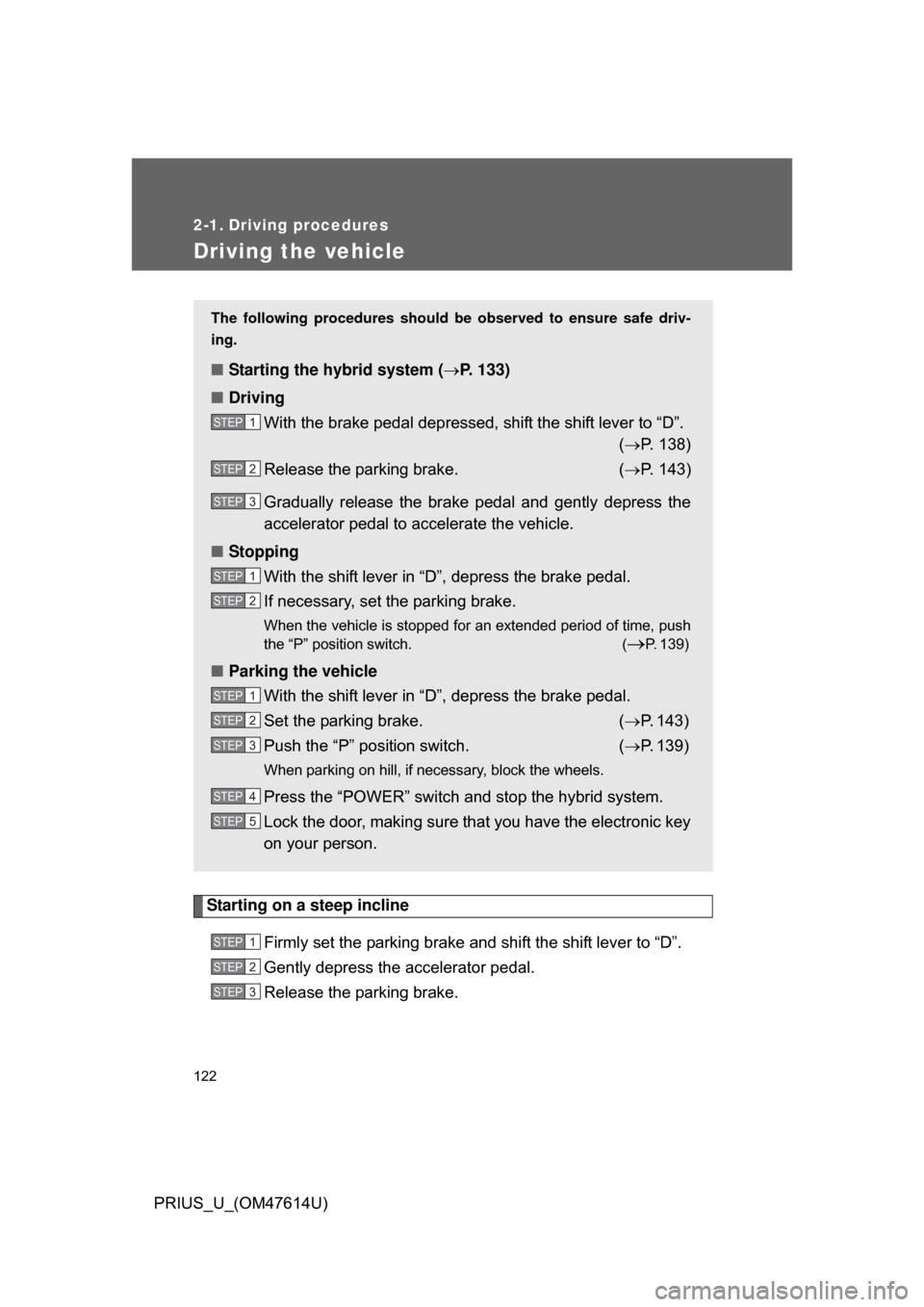
122
PRIUS_U_(OM47614U)
2-1. Driving procedures
Driving the vehicle
Starting on a steep inclineFirmly set the parking brake and shift the shift lever to “D”.
Gently depress the accelerator pedal.
Release the parking brake.
The following procedures should be observed to ensure safe driv-
ing.
■ Starting the hybrid system ( P. 133)
■ Driving
With the brake pedal depressed, shift the shift lever to “D”. ( P. 138)
Release the parking brake. ( P. 143)
Gradually release the brake pedal and gently depress the
accelerator pedal to accelerate the vehicle.
■ Stopping
With the shift lever in “D”, depress the brake pedal.
If necessary, set the parking brake.
When the vehicle is stopped for an extended period of time, push
the “P” position switch. (
P. 139)
■Parking the vehicle
With the shift lever in “D”, depress the brake pedal.
Set the parking brake. ( P. 143)
Push the “P” position switch. ( P. 139)
When parking on hill, if necessary, block the wheels.
Press the “POWER” switch and stop the hybrid system.
Lock the door, making sure that you have the electronic key
on your person.
STEP1
STEP2
STEP3
STEP1
STEP2
STEP1
STEP2
STEP3
STEP4
STEP5
STEP1
STEP2
STEP3
Page 123 of 508
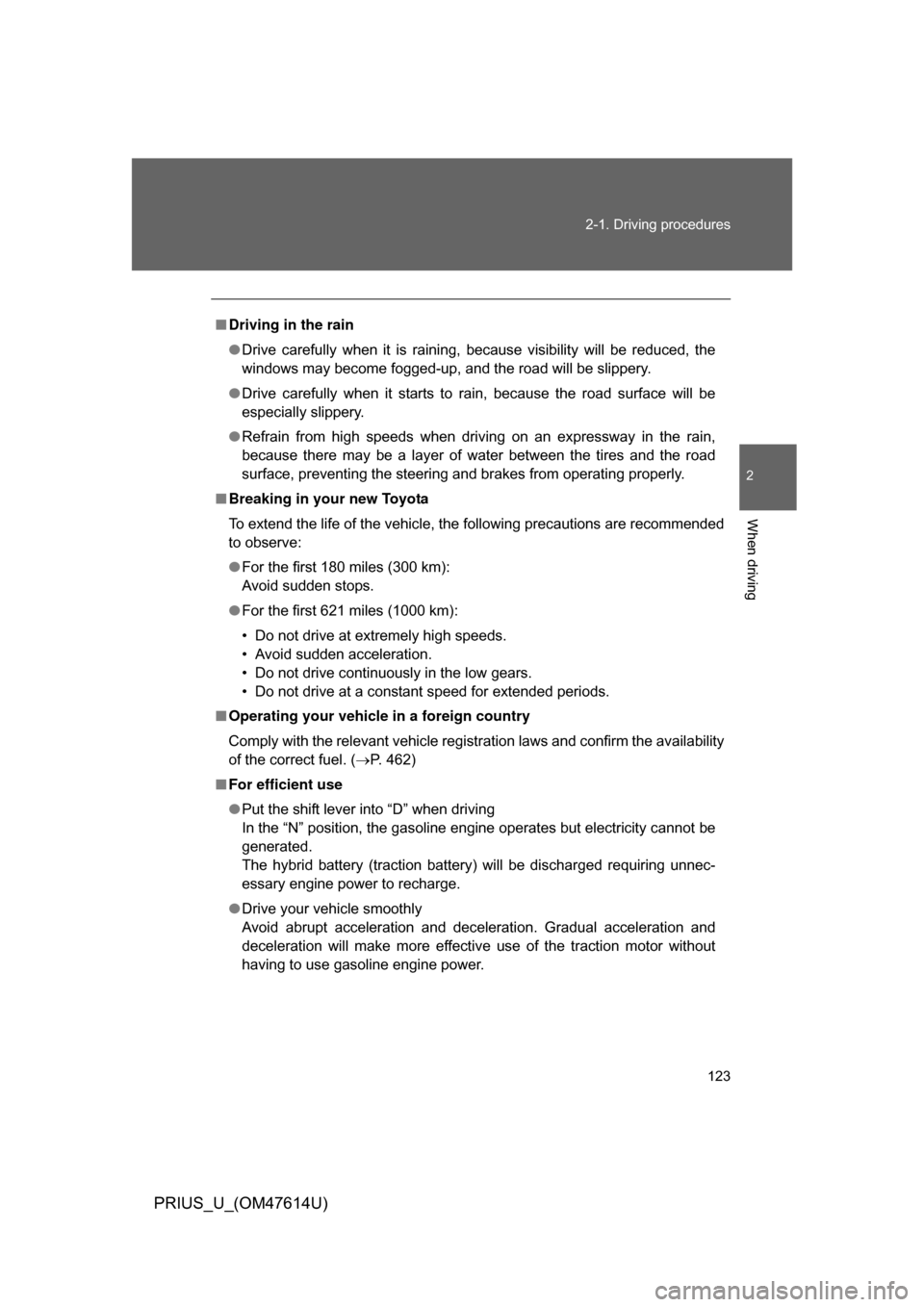
123
2-1. Driving procedures
2
When driving
PRIUS_U_(OM47614U)
■
Driving in the rain
● Drive carefully when it is raining, because visibility will be reduced, the
windows may become fogged-up, and the road will be slippery.
● Drive carefully when it starts to rain, because the road surface will be
especially slippery.
● Refrain from high speeds when driving on an expressway in the rain,
because there may be a layer of water between the tires and the road
surface, preventing the steering and brakes from operating properly.
■ Breaking in your new Toyota
To extend the life of the vehicle, the following precautions are recommended
to observe:
● For the first 180 miles (300 km):
Avoid sudden stops.
● For the first 621 miles (1000 km):
• Do not drive at extremely high speeds.
• Avoid sudden acceleration.
• Do not drive continuously in the low gears.
• Do not drive at a constant speed for extended periods.
■ Operating your vehicle in a foreign country
Comply with the relevant vehicle registration laws and confirm the availability
of the correct fuel. ( P. 462)
■ For efficient use
● Put the shift lever into “D” when driving
In the “N” position, the gasoline engine operates but electricity cannot be
generated.
The hybrid battery (traction battery) will be discharged requiring unnec-
essary engine power to recharge.
● Drive your vehicle smoothly
Avoid abrupt acceleration and deceleration. Gradual acceleration and
deceleration will make more effective use of the traction motor without
having to use gasoline engine power.
Page 125 of 508
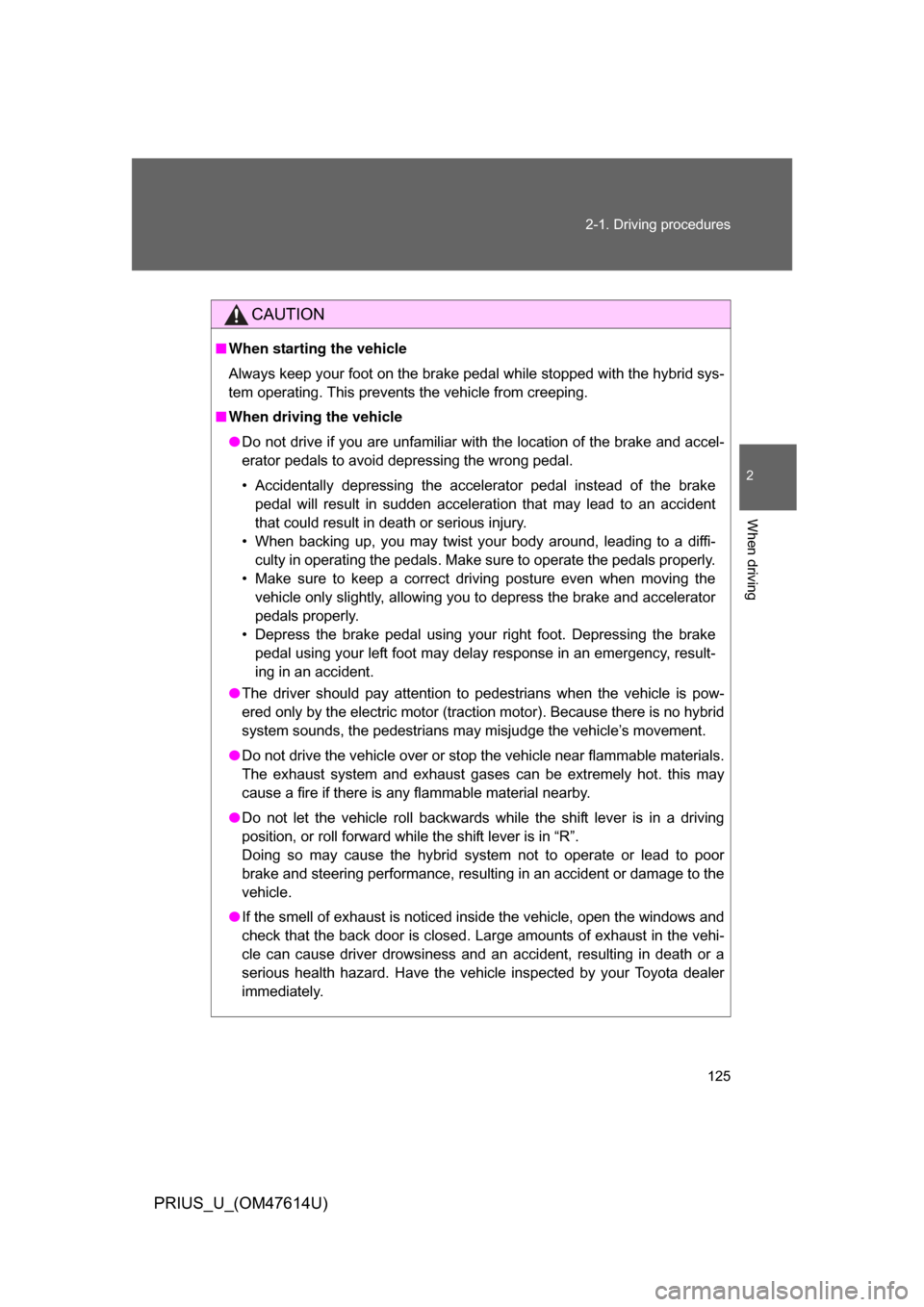
125
2-1. Driving procedures
2
When driving
PRIUS_U_(OM47614U)
CAUTION
■
When starting the vehicle
Always keep your foot on the brake pedal while stopped with the hybrid sys-
tem operating. This prevents the vehicle from creeping.
■ When driving the vehicle
● Do not drive if you are unfamiliar with the location of the brake and accel-
erator pedals to avoid depressing the wrong pedal.
• Accidentally depressing the accelerator pedal instead of the brake
pedal will result in sudden acceleration that may lead to an accident
that could result in death or serious injury.
• When backing up, you may twist your body around, leading to a diffi- culty in operating the pedals. Make sure to operate the pedals properly.
• Make sure to keep a correct driving posture even when moving the vehicle only slightly, allowing you to depress the brake and accelerator
pedals properly.
• Depress the brake pedal using your right foot. Depressing the brake pedal using your left foot may delay response in an emergency, result-
ing in an accident.
● The driver should pay attention to pedestrians when the vehicle is pow-
ered only by the electric motor (traction motor). Because there is no hybrid
system sounds, the pedestrians may misjudge the vehicle’s movement.
● Do not drive the vehicle over or st op the vehicle near flammable materials.
The exhaust system and exhaust gases can be extremely hot. this may
cause a fire if there is any flammable material nearby.
● Do not let the vehicle roll backwards while the shift lever is in a driving
position, or roll forward while the shift lever is in “R”.
Doing so may cause the hybrid system not to operate or lead to poor
brake and steering performance, resulting in an accident or damage to the
vehicle.
● If the smell of exhaust is noticed inside the vehicle, open the windows and
check that the back door is closed. Large amounts of exhaust in the vehi-
cle can cause driver drowsiness and an accident, resulting in death or a
serious health hazard. Have the vehicle inspected by your Toyota dealer
immediately.